Preventing flooring failures: Factors to consider in substrate prep
by tanya_martins | June 3, 2024 8:39 am
By David Gross
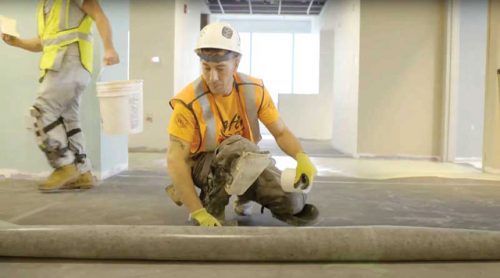 [1]
[1]
Substrate preparation is a crucial first step in the flooring installation process and it can significantly impact the appearance and longevity of the final flooring material. While most floor covering installers understand the concept of basic preparation steps such as cleaning and leveling, some are less experienced with the additional technical aspects of moisture and pH testing.
Without comprehensive knowledge of how moisture and pH impact flooring products and materials, an installer can place the entire installation at risk for callbacks down the road. According to Independent Floor Testing & Inspection (IFTI), the leading cause of flooring failures is moisture, costing the industry $2.4 billion each year in remediation.1
One way architects, designers, and specifiers can prevent moisture and pH from becoming problems in their flooring projects is by ensuring properly trained and certified installers are used to meet specifications. Certified installers, especially those who carry substrate prep certification, are trained to assess and correct moisture and pH issues, so flooring projects start on the right foot, and help protect the integrity of the floor’s performance and design.
To illustrate the importance of moisture and pH testing in successful installations and demonstrate why building professionals should require installers to be certified, here is a look at what can happen when these factors are left out of the equation.
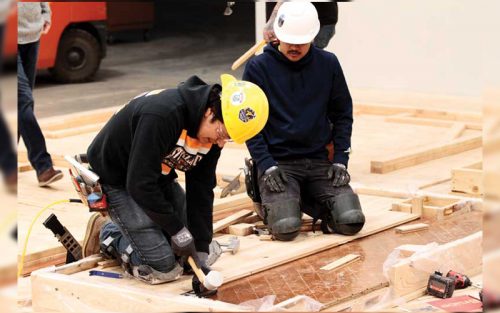 [2]
[2]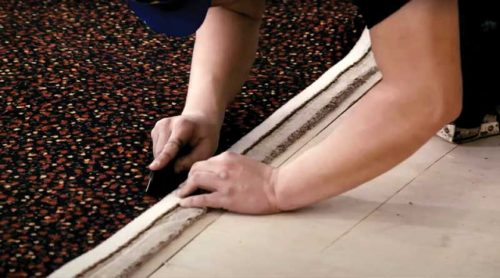 [3]
[3]Costly consequences of moisture and pH imbalances
For every flooring installation, substrate preparation should include consideration for moisture and the pH levels present in it.
Not properly accounting for moisture and pH, or ignoring them altogether, can lead to a host of issues, including adhesive failures, warping, mold growth, and overall degradation of the floor covering. It can also void the flooring manufacturer’s warranty when guidelines for moisture and pH conditions are not followed.
Some of the most common and most damaging moisture- and pH-related flooring problems include:
Carpet
- Mold and mildew growth—Moisture trapped under carpeting can create an ideal environment for mold and mildew, leading to unpleasant odors and health risks for occupants.
- Delamination—Exposure to moisture or excessive pH can cause the separation of the carpet’s backing layers and deterioration of the carpet material.
- Discoloration—Certain types of mold or mildew can cause staining or discoloration of the carpet fibers.
Hardwood
- Cupping—When the bottom of the wood absorbs more moisture than the top, the edges of the hardwood planks can curl upward, creating a concave surface.
- Crowning—The opposite of cupping, crowning is when the center of the plank swells with moisture and rises higher than the edges.
- Buckling—Extreme moisture can cause wood planks to pull away from the subfloor and significantly warp, in some cases rising several inches.
Vinyl (luxury vinyl [LVT], vinyl composition tile [VCT], sheet)
- Adhesive failure—Moisture and/or high pH can weaken or re-emulsify adhesives, causing tiles or planks to loosen, curl, or come off entirely.
- Telegraphing—Moisture can cause subfloor imperfections to become visible on the surface of the vinyl, as the material molds to the shape of the underlying surface.
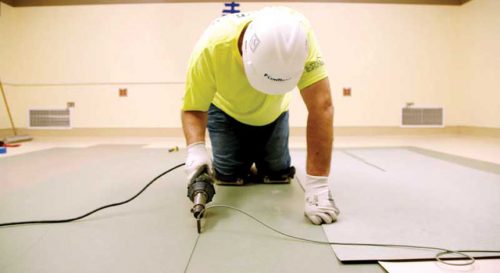 [4]
[4]- Bubbling or blistering—Trapped moisture beneath the vinyl can lead to unsightly bubbles or blisters on the surface.
- Discoloration—Excessive alkalinity (high pH) can lead to discoloration and deterioration over time.
Resinous materials (epoxy, polyurethane)
- Bonding issues—Excess moisture can prevent resinous materials from properly adhering to the substrate, leading to peeling or flaking.
- Blushing—Moisture can cause a cloudy or whitish appearance on the surface of resinous coatings.
- Curing problems—High moisture levels can interfere with the chemical curing process of resinous materials, leading to a tacky or soft finish.
Polished concrete
- Efflorescence—Moisture moving through the concrete and carrying salts to the surface creates a white, powdery residue.
- Spalling—Moisture can exacerbate flaking or chipping on the concrete surface due to freeze-thaw cycles or rebar corrosion.
- Dull finish—Excess moisture can dull the sheen of polished concrete, reducing its aesthetic appeal.
Regardless of the flooring material being installed or provided, such as polished concrete, excess moisture and high pH levels can create costly problems and callbacks for repairs or replacement.
Inspect, test, correct
As the flooring industry learns more about the impact of moisture on flooring materials and the costs associated with flooring failures, manufacturers are continuously developing new tools for moisture testing and new products for moisture control. These new tools and products are often specific to the manufacturer, and each manufacturer has different instructions and application guidelines. Such continuous change makes it challenging for installers who are not certified to stay current. Certified installers, on the other hand, are kept up to date on new testing tools, products, and application techniques as a requirement of maintaining their certification. They also understand that following manufacturer’s installation instructions is imperative for warranty protection and long-term flooring success.
To avoid moisture and pH pitfalls, a certified installer will inspect, test, and advise how to correct moisture and pH levels in the substrate before flooring installation begins. Prior to starting, a trained installer will visually inspect the substrate for signs of moisture and pH problems, such as efflorescence, staining, mold, and mildew. The installer will then follow up with moisture and pH testing to further assess conditions and ready the substrate for installation.
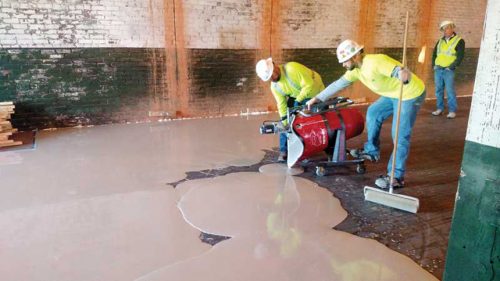 [5]
[5]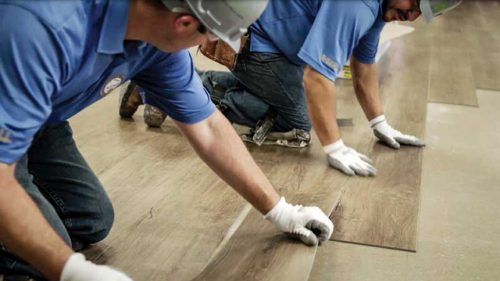 [6]
[6]Moisture testing
Common tests used by certified installers include the calcium chloride test, which measures moisture vapor emission rates (MVER) according to ASTM F1869, Standard Test Method for Measuring Moisture Vapor Emission Rate of Concrete Subfloor Using Anhydrous Calcium Chloride, and the relative humidity (RH) test, which measures moisture content within concrete substrates according to ASTM F2170, Standard Test Method for Determining Relative Humidity in Concrete Floor Slabs Using in situ Probes. These tests help determine if the moisture level is within the flooring material and the adhesive manufacturer’s recommended range or if mitigation is required.
Newer testing methods using Bluetooth technology are also making their way into the flooring industry with meters capable of capturing moisture data and storing it in the cloud. Tech-enabled testing tools such as these are particularly desirable for big-budget commercial projects where flooring failure would be extremely costly. They are also becoming valuable tools for building superintendents, as maintenance staff can monitor conditions such as air temperature and RH, and the superintendent can remotely view the data.
pH testing
Installers can assess pH following ASTM F710, Standard Practice for Preparing Floors to Receive Resilient Flooring. Place several drops of distilled or deionized water on a clean concrete surface to form an approximately 25 mm (1 in.) diameter circle. After 60 seconds, plus or minus five seconds, measure pH using a strip. A certified installer will conduct pH tests in multiple locations to account for variability in moisture content and other factors affecting pH readings.
If results of the inspection and testing indicate the need for mitigation, a certified installer will then choose an appropriate solution, such as one of the following:
Adding a vapor barrier
The installer may investigate to ascertain if a vapor barrier was utilized underneath a concrete slab before it was poured, which controls moisture after the slab has cured. Vapor barriers can also be applied to walls to limit moisture migration into the flooring.
Applying a surface treatment
A surface moisture mitigation system can be used to prevent moisture vapor from affecting the flooring. These systems typically use an epoxy or urethane base coating to create a near impermeable barrier on the flooring surface.
Incorporating ventilation and dehumidification
In some cases, controlling the indoor environment with dehumidifiers and adequate ventilation can contribute to moisture levels.
Ensuring proper drainage
Drainage around a building may be modified to prevent water from accumulating at the foundation and moisture from entering the substrate area.
Neutralizing pH
If pH levels are outside the recommended range for the specified flooring products, a certified installer will take measures to neutralize the surface. This might involve applying specialty primers or sealers to buffer the pH and provide a suitable surface for flooring installation.
Two of the latest advances in moisture mitigation are one-step surface treatments and adhesive formulations that include moisture control. One-step surface treatments eliminate the bead-blasting step that typically precedes epoxy application. Likewise, combination adhesive and moisture control products consolidate two installation tasks into one, but they also require a specific application process. A certified installer understands these new solutions and has the resources to quickly access installation instructions for individual product manufacturers. This not only saves time on the installation, but also ensures successful flooring results.
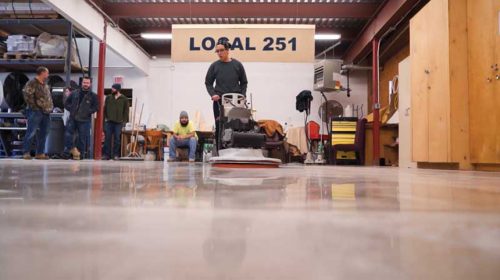 [7]
[7]Certified installers bring more to the floor
Proper substrate preparation is fundamental to the success and longevity of every flooring installation. For architects, designers, and specifiers, partnering with certified installers helps guarantee this success, as these highly trained professionals are skilled at diagnosing issues such as moisture and pH and resolving them to produce optimal results and avoid costly repairs. Collaboration with a certified installer not only enhances the integrity of the flooring installation, but it also elevates the quality of the entire project; successful projects mean happy clients.
Notes
1 To learn more, visit https://ifti.com/how-much-money-is-wasted-due-to-flooring problems-every-year/.
Some installation issues relate to buckling, crowning, and cupping.
Some of the most common and most damaging, moisture-
and pH-related flooring problems include carpet mold and mildew growth, delamination, and discoloration.
Substrate preparation is a crucial first step in the flooring installation process, and it can significantly impact the appearance and longevity of the final flooring material.
Resinous materials such as epoxy and polyurethane face common issues such as blushing, bonding, and cursing problems
Some of the most common vinyl problems are related to adhesive failure, telegraphing, discoloration, and bubbling/blistering.
When polishing concrete some common issues installers may face
are spalling, dull finish, and efflorescence.
 [8]
[8]
- [Image]: https://www.constructionspecifier.com/wp-content/uploads/2024/06/INSTALL-Inspection-1.jpg
- [Image]: https://www.constructionspecifier.com/wp-content/uploads/2024/06/Hardwood-BTC-2-1.jpg
- [Image]: https://www.constructionspecifier.com/wp-content/uploads/2024/06/INSTALL-Carpet-1.jpg
- [Image]: https://www.constructionspecifier.com/wp-content/uploads/2024/06/INSTALL-2-1.jpg
- [Image]: https://www.constructionspecifier.com/wp-content/uploads/2024/06/INSTALL-Hennsville-01-1.jpg
- [Image]: https://www.constructionspecifier.com/wp-content/uploads/2024/06/INSTALL-LVP-installation-1-1.jpg
- [Image]: https://www.constructionspecifier.com/wp-content/uploads/2024/06/INSTALL-Concrete-Polishing-1-1.jpg
- [Image]: https://www.constructionspecifier.com/wp-content/uploads/2024/06/David-Gross_Headshot.jpg
Source URL: https://www.constructionspecifier.com/preventing-flooring-failures-factors-to-consider-in-substrate-prep/